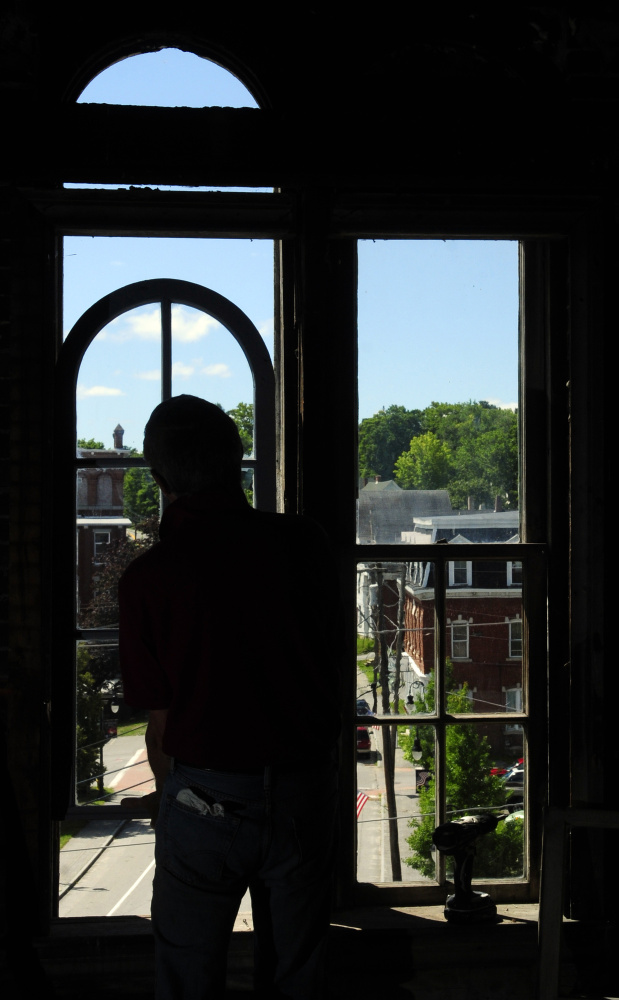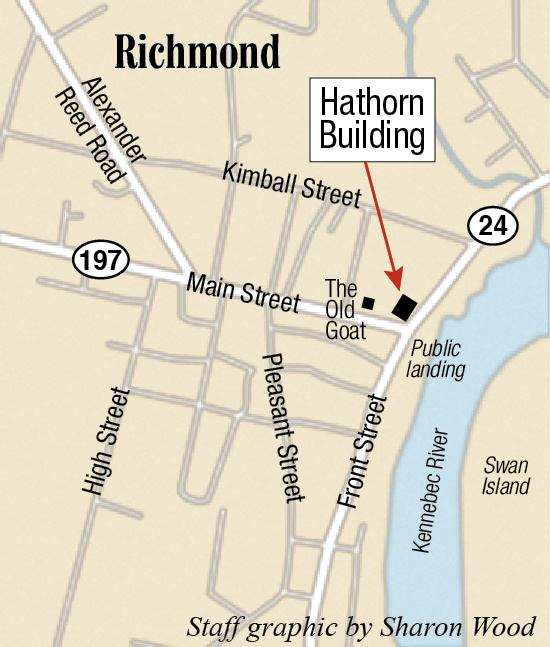Everything the developers of Richmond’s Hathorn Block need to start construction is lined up and ready to go — everything but the construction money.
In the next month or so, Fossel Preservation Partners are expected to decide whether to continue to pursue historic preservation tax credits to fund construction of apartments in Richmond’s marquee historic building on the Kennebec River, or instead to seek traditional construction financing to develop condominium units.
“There’s an advantage to the town if I don’t use tax credits,” said Les Fossel, managing partner of Fossel Preservation Partners.
He’s joined in this venture by architect David Landmann, John Hochstein and Fred Gumkowski, the project manager.
“We won’t make as much money, but the value will be much higher,” Fossel said. If apartments were built there, the town of Richmond could collect about $30,000 in annual real estate taxes on the building. But if the Hathorn Block is developed into individually owned units, Richmond could collect about $10,000 more every year, he said.
When Fossel first announced his intention to buy and redevelop the building, the plan hinged on historic tax credits. But now, a year later, he said he hasn’t seen much progress on that front. Their consultant is asking for more information.
“This is how bureaucracy works,” the Republican former state lawmaker from Alna said. “There is no incentive to shorten forms, and your life becomes bound up in forms.”
Using tax credits also would restrict him and his partners from converting apartments to condominiums sooner than five years from now, he said; and based on some recent feedback, he believes interest exists in having condominium units in the building.
During Richmond Days in late July, Fossel was offering limited tours and a presentation showing what work has been accomplished since the building changed hands in October 2015. About 300 people took him up on the offer. Of that number, about 80 requested more information on what will happen next, and many indicated interest in condos.
When brothers Jefferson and Joseph Hathorn started construction of the Hathorn Block in 1849, the waterfront building was on track to be the largest in town. According to the history of the building documented by John Alley Robbins Jr., the Hathorn Block was used as living space by Joseph Hathorn and his family and as warehouse space starting in 1850. The building because home to the Richmond Bank, the town’s first bank, in 1852.
Over time, the building was home to several grocery and dry goods stores, the post office twice — including the time in the late 1890s when robbers tried to blow up a safe in the middle of the night and ignited a serious fire.
In the 20th century, the building was home to a succession of shops, professional offices and apartments.
When the project was launched last fall, the first critical projects were restoring the exterior masonry, stabilizing the building and replacing its windows.
Fossel has been channeling his frustration at the delays into rebuilding the windows himself. Virtually all the glass he’s used has come from the building, cut with the commercial-grade glass cutter he bought for the project. He estimates he’s saved about $60,000 in doing it himself.
“All the arched windows but one are in place,” he said, adding that the one that’s not is waiting for new glass to replace a pane Fossel said he broke.
“Sometimes it’s hard to see progress when there’s so much work to be done,” said Victoria Boundy, Richmond’s director of community and economic development.
To date, Boundy said, the bulk of the work has been in the building’s interior. But what people can see most easily, she said, is the work on the windows. And when they are painted, she said, they will be beautiful.
Next on the building’s project list are the windows and doors on the ground-floor commercial level on Main Street.
Even with the delay, Fossel said the project still is expected to be completed in early 2017. With the interior demolition long since completed and the architectural plans done and subcontractors lined up, the funding is the last piece.
“I’m 69 now,” he said. “I’d like to be done by the time I’m 71.”
Jessica Lowell — 621-5632
Twitter: @JLowellKJ
Copy the Story LinkSend questions/comments to the editors.






Success. Please wait for the page to reload. If the page does not reload within 5 seconds, please refresh the page.
Enter your email and password to access comments.
Hi, to comment on stories you must . This profile is in addition to your subscription and website login.
Already have a commenting profile? .
Invalid username/password.
Please check your email to confirm and complete your registration.
Only subscribers are eligible to post comments. Please subscribe or login first for digital access. Here’s why.
Use the form below to reset your password. When you've submitted your account email, we will send an email with a reset code.